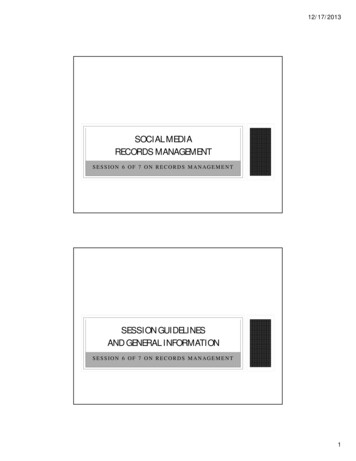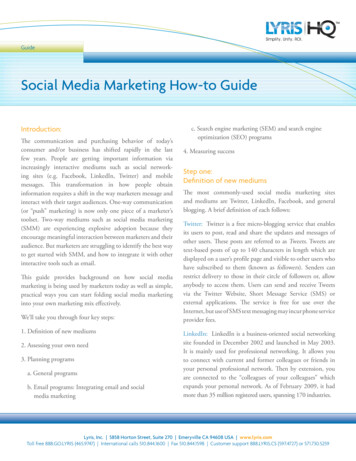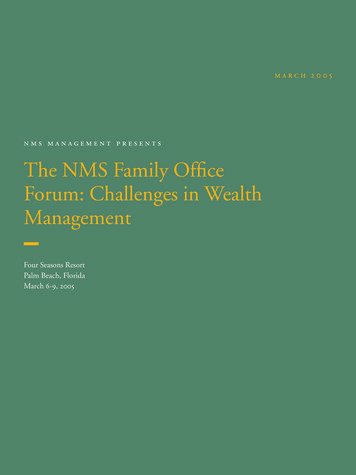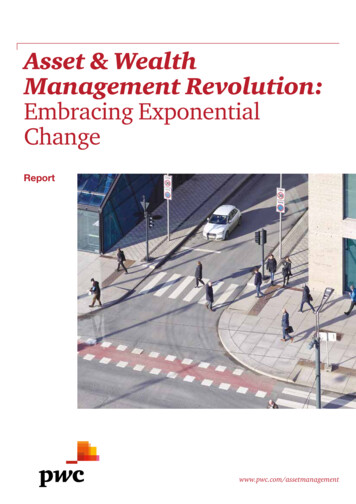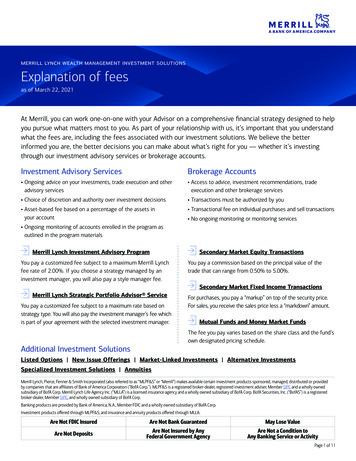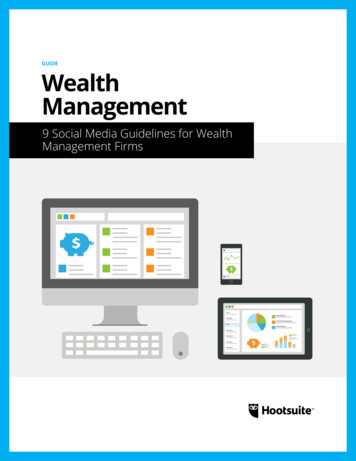
Transcription
GUIDEWealthManagement9 Social Media Guidelines for WealthManagement Firms
Wealth Management9 Social Media Guidelines for Wealth Management FirmsWealth management firms that embrace social media canposition themselves to gain advantage in a financial servicesmarket where brand image, reputation, and new businessopportunities greatly depend on client-generated reviewsand content. Additionally, wealth management firms andfinancial advisors who use social media in a strategic andcompliant fashion can turn negative perceptions or serviceissues into business wins and loyal clients.A recent Putnam Investments study reported that 75percent of wealth management advisors use at least onesocial network for business, and 49 percent of advisorshave used social media to acquire new clients. AnAccenture survey revealed that financial advisors can usesocial platforms to forge deeper, stronger relationshipswith existing clients and recruit new clients. Forty percentof financial advisors said they had acquired new clientsthrough Facebook, 25 percent through LinkedIn, and 21percent through Twitter. The same survey found thatinternal social communities helped financial advisorsconnect with in-house experts to answer complexcustomer questions.Investors are eager to connect with their financial advisorson social media. The 2014 World Wealth report fromCapgemini and RBC Wealth Management reported thattrust and confidence in financial advisors is on the riseafter reaching almost historic lows in recent years. Theimprovement is partially attributable to social mediaproviding a platform for open, meaningful dialogue withpotential clients. The survey also reported that 41 percentof high net worth individuals under the age of 40 cite socialmedia as important for accessing information, 36 percentfor engaging with wealth managers and firms, and 34percent for executing transactions.Cogent Research reports that 34 percent of affluentinvestors are using social media platforms for personalfinance and investing reasons, and that nearly 70percent have reallocated investments, or began oraltered relationships with investment providers based oninformation discovered on social media.These statistics reinforce how important it is for wealthmanagement firms, asset managers, and financial advisorsto have a strong and proactive social media strategy.However, some firms have been reluctant to use socialmedia because of the liability and reputational risksstemming from erroneous or inappropriate postings.Fortunately, fears or risks concerning security, regulatoryguidelines, or compliance can now be mitigated by asolid social media foundation, defined workflows, and aneducated investment in a social relationship platform.Hootsuite developed this guide to help you implementa social media strategy that supports your businessgoals and delivers measurable ROI, ensures your wealthmanagement firm adheres to all compliance requirements,and is backed by a social relationship platform that meetsthe needs of social media stakeholders across yourorganization.WEALTH MANAGEMENT: 9 SOCIAL MEDIA GUIDELINES FOR WEALTH MANAGEMENT FIRMS2
Guideline 1: Take Control of Your Social Media PresenceAny social media account linked to your brand can affectyour firm’s credibility, reputation, and compliance, yetmany wealth management firms may not know the fullextent of social media use in their organization. Hootsuiteprovides audit capabilities and the ability to centralizeownership of all social media accounts. Inventory all social media accounts associated withyour brand. Look for local social media initiativesby managers or advisors, dormant accounts thatmay have been established for a one-off marketingcampaign, and accounts associated with subsidiariesor international offices. Centralize ownership of social media profiles.Hootsuite provides centralized account provisioning,a multi-layered permission system for publishing,checks for regulatory compliance, and archivalof public and internal social messaging to meetretention and retrieval requirements for your firm. Protect your social media accounts. Hootsuiteenables you to implement secure single sign-onfor users and assign permission levels that can bemodified centrally.The average enterprise has 178social media profiles.WEALTH MANAGEMENT: 9 SOCIAL MEDIA GUIDELINES FOR WEALTH MANAGEMENT FIRMS3
Guideline 2: Establish a Social Media Strategy to Achieve Business GoalsBring all departments together, including Marketing, Sales,Customer Service, Human Resources, Compliance, and ITto ensure you have a unified social strategy that promotes aconsistent brand voice and presence, fosters collaborationthat amplifies your social media efforts, avoids duplication,and is aligned with enterprise business goals. Identify business objectives first, then determine howsocial media initiatives can support those objectives. Solicit recommendations from all stakeholders inyour firm, from executives to asset managers tofront-line social media users, then build consensuson the best strategy to adopt. Shape your strategy across teams, business units,and regions by tagging keywords and listening towhat is being said on social networks about yourfirm, brand, investment products, services, industry,and competitors. You will be able to uncoveropportunities for engaging with clients. Formalize processes and workflows for receiving,sharing, and responding in a compliant manner toclient messages over social networks. An incomingmessage could be a question about investmentopportunities, current accounts, career advice, andmore. Plan ahead to make sure the right people areinvolved and you respond to the client in a timelyand appropriate manner.WEALTH MANAGEMENT: 9 SOCIAL MEDIA GUIDELINES FOR WEALTH MANAGEMENT FIRMS4
Guideline 3: Be Proactive About Regulatory ComplianceWealth management firms today are using robust socialrelationship platforms such as Hootsuite to mitigaterisks, ensure compliance, and confidently engage insocial marketing, selling, and customer service. Hootsuiteoffers functionality to review all posts before and afterpublishing to ensure compliance. Become familiar with regulations andrecommendations from FINRA, FFIEC, the SEC, andother regulatory bodies. There are also numerousstate and regional laws and countless legal casesthat have set the rules for what investment advisorscan and can’t do with social media. Hootsuite keepsup-to-date on regulatory guidelines and providesplatform functionality for firms to remain compliant. Categorize and archive all social media contentfor quick retrieval to meet regulatory guidelines.Archiving can be a complex process given theinteractive and real-time nature of social media, butHootsuite can automatically perform this task. Hootsuite can help you develop custom corporatecompliance guidelines into your workflow. Use a social relationship platform such as Hootsuiteto create compliant workflows that eliminateburdensome and time-consuming email threadsbetween social media content producers andcompliance officers.WEALTH MANAGEMENT: 9 SOCIAL MEDIA GUIDELINES FOR WEALTH MANAGEMENT FIRMS5
Guideline 4: Train & Educate the Entire TeamAn educated workforce that is well-trained to be socialmedia proficient is not just a competitive necessity buta regulatory one as well. According to the FinancialProfessionals Social Media Adoption study conducted byAmerican Century Investments, 69 percent of financialprofessionals now have formal social media policies attheir firm. Create a “playbook” of policies and guidelines forsocial media usage and compliance. Develop processes around account permissions andmessage approvals. Focus training efforts on how to use social mediaeffectively to achieve business goals. Consider an external certification program such as theone offered by the S.I. Newhouse School of PublicCommunications and Hootsuite to provide a formalframework for social media training and strategy. Educate executives who can be high-profile leadersof internal social initiatives as well as your best brandambassadors on external social media.WEALTH MANAGEMENT: 9 SOCIAL MEDIA GUIDELINES FOR WEALTH MANAGEMENT FIRMS6
Guideline 5: Engage Customers LocallyWhether you are a partner in a small group of certifiedfinancial professionals or a multinational investmentbank with hundreds of locations, you need to connect withcustomers where they live and work. Monitor industry terms or brand mentions based onlocation using the geolocation functionality offeredby Hootsuite. This will reduce incoming noise andallow local social media users to see only localmessages. Create a virtual perimeter, called a geofence, arounda real-world geographic area to target outboundsocial media messages by country, state, region,or city so followers see content relevant to theirlocation. Listen to what your customers are saying on socialmedia. Many of their conversations and posts maybe related to insurance needs, such as birthdays,car shopping, house hunting, marriages, and otherlife events. Using this insight, you can craft intelligentresponses. Use your social media accounts to communicateinformation if catastrophic events occur, from safetytips to making claims. Use demographic targeting to reach specificsegments of consumers based on age, gender,relationship status, education level, and otherattributes.WEALTH MANAGEMENT: 9 SOCIAL MEDIA GUIDELINES FOR WEALTH MANAGEMENT FIRMS7
Guideline 6: Define Workflows to Deliver Better Customer SupportMcKinsey & Company reports that social media offerscompanies the ability to redefine the delivery of service tocustomers while dramatically lowering costs. Create anddocument a triage process for categorizing, reviewing, andresponding to inquiries and complaints from clients oversocial media networks. Work with Compliance and Public Relations todetermine which messages should not be respondedto over public channels or responded to at all, or toidentify any individuals that should be blocked. Protect your clients’ privacy by educating yourteam about when to take conversations off publicsocial media networks and into other channels ofcommunication. Respond quickly to clients but avoid stock responseswhen possible. It’s useful to have a library of legallyapproved content from your Marketing department.If possible, respond individually, which carries greaterinfluence and results in stronger customer affinity. Access in-house experts and escalate issues asneeded to resolve client problems and answerquestions.WEALTH MANAGEMENT: 9 SOCIAL MEDIA GUIDELINES FOR WEALTH MANAGEMENT FIRMS8
Guideline 7: Measure and Analyze to Demonstrate ROISocial media lends itself to measurement and analyticsbecause it creates data that can lead to intelligent action.According to Advisor Websites blog, social analyticsprovides valuable information that can help direct youroverall online strategies and enhance your social mediaengagement initiatives. Tie your social media strategy to specific businessgoals and identify the relevant metrics that willsupport those goals and deliver ROI. Track social media customer care metrics such asresponse times, time to resolution, and number ofcase resolutions through a specific social channel. The Hootsuite social relationship platform works withpopular analytics packages such as Google Analyticsand Omniture. You can measure not only comments,likes, and followers, but also perform end-to-endtracking of consumer behavior such as click-throughsto your website, campaign conversions, leads,revenue, and other strategic outcomes attributableto social media initiatives. Apply the intelligence you gain to optimize programs,hone your message, and invest in social mediapromotions that deliver the highest return.WEALTH MANAGEMENT: 9 SOCIAL MEDIA GUIDELINES FOR WEALTH MANAGEMENT FIRMS9
Guideline 8: Develop a Robust Content StrategyYou are is likely to be using multiple social networksas part of your strategy, including Twitter, LinkedIn,Facebook, and others. You will need to stay active onthese networks and develop an effective content strategyto keep your audience engaged. The American CenturyInvestments study reported that the top three types ofinformation financial professionals want from assetmanagers are commentary/market insight, market news,and educational content to share with clients. Monitor messages and campaigns to discover whatresonates with your audience, then spread effectivemessages across multiple channels. Use content discovery capabilities to find andsuggest relevant, interesting content that will engageand educate your social media followers. Deliver content that highlights your brand attributesand positions financial advisors as experts ininvestors’ needs. For example, educate consumersabout the different types of investment instruments,saving for retirement or college, or how to developan individual risk profile. Produce a mix of content for social media publishing.A good rule of thumb is 30 percent original thoughtleadership/educational content, 50 percent curatedcontent from other sources, and 20 percentpromotional content. Develop an editorial calendar and publishingschedule. Hootsuite lets you plan social media postsin advance and schedule their automatic publication.WEALTH MANAGEMENT: 9 SOCIAL MEDIA GUIDELINES FOR WEALTH MANAGEMENT FIRMS10
Guideline 9:Make theNecessaryCommitment toAchieve SuccessForward-thinking wealth management firms arecommitting to the necessary step of using a socialrelationship platform such as Hootsuite to accelerateand derive measurable business value from their socialmedia efforts. A social relationship platform isn’t simply aconvenient way to manage social media, it’s the foundationof your ability to integrate all stakeholders and to executean effective and compliant social media strategy in supportof business objectives.Get started today.
About Hootsuite EnterprisePartner with Hootsuite to accelerat
social network for business, and 49 percent of advisors have used social media to acquire new clients. An Accenture survey revealed that financial advisors can use social platforms to forge deeper, stronger relationships with existing clients and recruit new clients. Forty percent of financial advisors said they had acquired new clients

